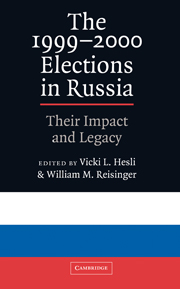Book contents
- Frontmatter
- Contents
- Contributors
- Acknowledgment
- SECTION I INTRODUCTION
- SECTION II PARTIES IN THE ELECTORATE
- SECTION III THE ROLE OF REGIONAL POWER
- SECTION IV PARTIES AND INSTITUTIONS
- 8 Instrumental Democracy: The End of Ideology and the Decline of Russian Political Parties
- 9 The Impact of the 1999–2000 Parliamentary and Presidential Elections on Political Party Development
- 10 Resolving the Problem of Preelection Coordination: The 1999 Parliamentary Election as an Elite Presidential “Primary”
- 11 Coalition Politics in the New Duma
- SECTION V CONCLUSION
- Bibliography
- Index
9 - The Impact of the 1999–2000 Parliamentary and Presidential Elections on Political Party Development
Published online by Cambridge University Press: 23 October 2009
- Frontmatter
- Contents
- Contributors
- Acknowledgment
- SECTION I INTRODUCTION
- SECTION II PARTIES IN THE ELECTORATE
- SECTION III THE ROLE OF REGIONAL POWER
- SECTION IV PARTIES AND INSTITUTIONS
- 8 Instrumental Democracy: The End of Ideology and the Decline of Russian Political Parties
- 9 The Impact of the 1999–2000 Parliamentary and Presidential Elections on Political Party Development
- 10 Resolving the Problem of Preelection Coordination: The 1999 Parliamentary Election as an Elite Presidential “Primary”
- 11 Coalition Politics in the New Duma
- SECTION V CONCLUSION
- Bibliography
- Index
Summary
Despite widespread fears that they might be postponed or even canceled, the parliamentary and presidential elections of 1999 and 2000 were carried out in an orderly fashion, and voter turnout in each election matched the impressive levels seen in the 1995 and 1996 elections for the legislature and the president. The presidential election was held about three months ahead of original schedule due to the sudden resignation of Boris Yeltsin on December 31, 1999. The vote conformed fully to an onerous constitutional provision that severely limits the time allowed for holding new elections in the event of the president's resignation or death. Balloting was carried out within three months and the constitution was not infringed. Even as war raged in Chechnya, no major incidents of terrorism or other organized violence disrupted the elections.
As in the 1995 parliamentary election, a bewildering number of parties competed in the party-lists portion of the balloting for the Duma in 1999, but only a handful cleared the 5-percent threshold for representation in parliament (see Table 1.1 in Chapter 1). The performance of parties created some appearance of continuity between elections, with three of the four parties that cleared the 5-percent barrier in 1995 doing so again in 1999. What is more, the percentage of the vote “wasted” – that which went to parties that failed to secure the 5-percent minimum – declined steeply, from 49 in 1995 to 19 percent in 1999.
- Type
- Chapter
- Information
- The 1999–2000 Elections in RussiaTheir Impact and Legacy, pp. 186 - 212Publisher: Cambridge University PressPrint publication year: 2003
- 8
- Cited by

